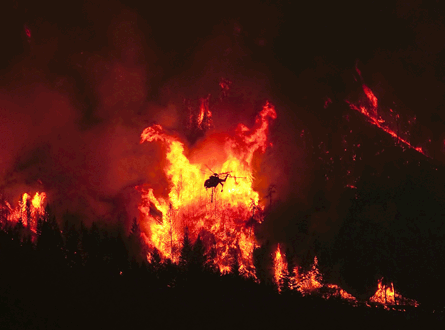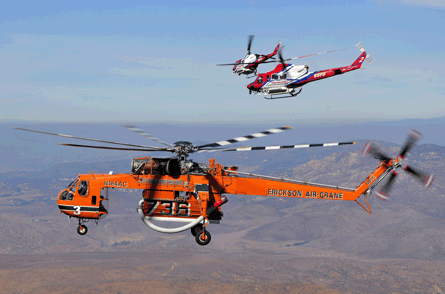Australia's 2010-11 bushfire season, which drew to a close in April, was a fairly quiet one for much of the country, with the exception of Western Australia, where a record hot summer kept the aerial firefighting fleet busy.
Nevertheless, a 52-strong national fleet of aircraft and helicopters contracted by the National Aerial Firefighting Centre (NAFC) was on standby throughout the season in the country's hotspots, along with the aerial firefighting fleets of individual states and territories. The 2010-11 fleet was the largest ever contracted by the NAFC.
"On the fire activity side it was a reasonably low activity level, except for [Western Australia]," says Richard Alder, general manager of the NAFC. However, the fleet was put to use providing support for other emergencies during the season, including flood relief activities in Queensland, Victoria, New South Wales and Western Australia in early 2011.
 |
|---|
© Erickson Air-CraneAustralia continually looks for weapons against the ever-present danger of summer fires |
Despite the quiet season, for the NAFC and individual states there is an ongoing process of evaluating platforms, new technology and approaches to manage the ever-present danger of fire in the summer. Australia continues to evaluate large and very large air tankers, despite the country's first trial of a very large tanker, a McDonnell Douglas DC-10-30, indicating it to be not particularly effective.
ON TRIAL
In the 2009-10 fire season, Victoria conducted a 10-week trial of a DC-10-30 supplied by US company 10 Tanker Air Carrier. The trial followed the devastating Black Saturday fires in Victoria in February 2009. These claimed 170 lives and prompted the country to reassess all aspects of bushfire management and control.
The idea was to deploy the DC-10-30, with its capacity of 45,400 litres (12,000USgal), in active wildfires during the season to test its suitability for Australian weather and environmental conditions, but a mild fire season meant that the aircraft was only deployed to one bushfire, where it dropped one load.
"While the drop was on target, the fire behaviour did not seriously challenge the drop owing to moderate weather and discontinuous fuels, leaving the question of its effectiveness in wildfire conditions unanswered," says the Bushfire Co-operative Research Centre (CRC), which was responsible for analysing the data from the trial and compiling a report.
Five missions were conducted using the DC-10 to assess the aircraft's firefighting capabilities, but none of these were conducted under conditions typically found in a severe wildfire, according to the Bushfire CRC.
During the missions, the aircraft drops produced alternating thick and thin sections of coverage, with the latter allowing fire to cross over with minimal slowing effects due to a combination of fast drop speed and the design of the delivery system. One drop caused severe damage to vegetation. "This drop could have potentially injured people or damaged buildings and highlights the need to ensure that people are not in the drop zone. Clearly, the significant potential for damage from a drop precludes a role in an urban interface situation while safe drop heights cannot be guaranteed," says the report.
 |
|---|
© Erickson Air-CraneErickson Air-Crane helicopters are routinely deployed down under |
As a result, the Bushfire CRC concluded that based on the evidence from the trial, such an aircraft is not suitable for effectively suppressing fires under most Australian wildfire conditions. "The results from these evaluations missions indicate that there are often problems with the consistency of many drops from the DC-10 air tanker," says the report.
Despite the Bushfire CRC's conclusions, valuable data was gathered in the DC-10 trial and the use of large or very large air tankers has not been discounted, says the NAFC's Alder. "We had some issues in the drop pattern which were of concern, but we're not ruling out the use of [very large tankers]," he says, adding that evaluations will continue, although no more trials are currently planned. "A fair bit is known on their operation in other countries, but we really need data from Australia," he adds.
No large tanker took to the Australian skies for the 2010-11 fire season. However, a Convair 580 was tested in the country for the first time. Two aircraft were leased from Conair in Canada for a 12-week trial in Victoria, through Field Air. The A$4 million ($4.2 million) trial was mainly funded by the Victorian government, with a contribution from the NAFC. The Bushfire CRC will report the findings in June.
The Convair 580 can carry 8,000 litres of water, foam or fire retardant in its large belly tank. It was tested over a variety of terrains. The aircraft performed more than 40 flights in trials, with "pretty good data" gathered and the aircraft performing as it was supposed to, according to Alder. The aircraft is typically used in North America for first-attack missions and for laying retardant lines in forest and grass fires.
SURVEILLANCE TECHNOLOGY
In addition to looking at platforms, the NAFC is also evaluating new surveillance and sensor technology, communications systems and unmanned aerial systems, which could all play a useful role in battling and managing bushfires. The NAFC's 2008 Future Aerial Fire Management Capability request for proposals opened the lines of communications with suppliers of large tankers and UAS and other systems, and evaluations have continued since then.
NAFC says it "sees great potential in continuing to develop the use of aerial platforms for acquiring intelligence during fire and emergency operations to provide timely and reliable information to affected communities and incident management teams".
This project included the testing last year of an Airborne Surveillance (Australia) Britten-Norman Defender equipped with a Wescam MX15HDi electro-optical infrared device, a purpose-built surveillance management system and a Link Systems microwave downlink. The South Australian Country Fire Service conducted a one-month trial of the aircraft that included day and night missions using prescribed burns to simulate bushfires.
The project also involved a Coulson Aircrane Sikorsky S-76 helicopter, equipped with integrated high-definition electro-optical sensors and mapping and communications packages, for intelligence-gathering. The trial was successful and provided valuable data on aerial surveillance platforms, sensor packages and integration and communication systems, says Alder. "Obtaining good quality intelligence is a priority," he adds.
Another project is examining the potential of UAS in supporting fire operations. "UAS technology has advanced significantly in recent years and we are keen to closely evaluate the potential application of UAS in fire support," says the NAFC. This project has included desktop studies and a demonstration involving Insitu Pacific's ScanEagle UAS, conducted in 2009 at Kilcoy airfield in Queensland. Airspace issues are being worked through with the Civil Aviation Safety Authority to allow progress to the next stage: namely, an operational trial under real conditions.
"The work we've done so far has seen the concept validated, but we now need to test it operationally," says Alder. "The general feeling is there's potential [in UAS technology]. It's not going to be a revolution. We are aware of its limitations, but it also provides real advantages, particularly in obtaining intelligence, for example at night."
Australia could see UAS operating in an intelligence-gathering role in aerial firefighting in five to 10 years, predicts Alder.
Source: Flight International























